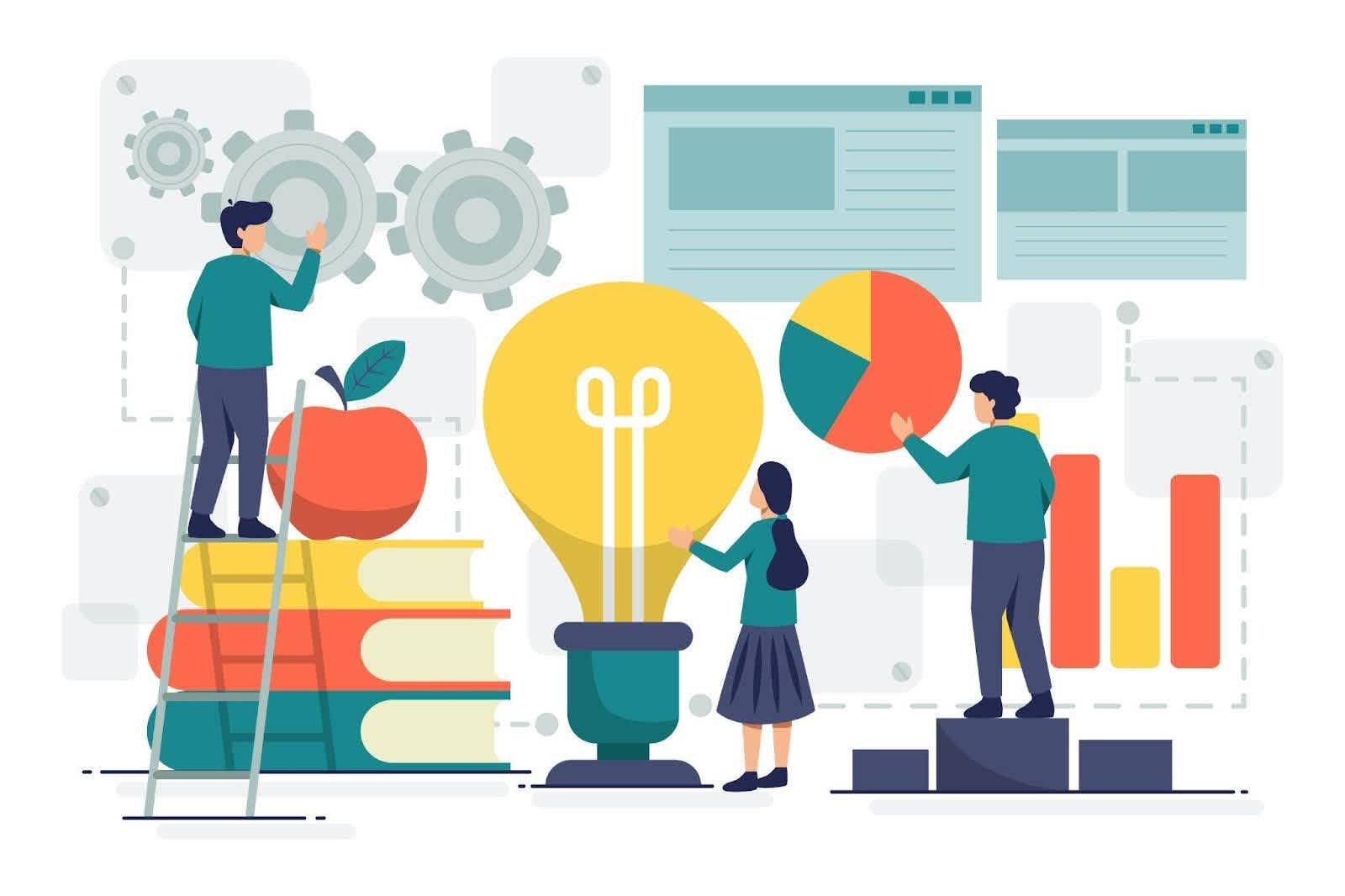A Comprehensive Guide to Upskilling Employees with Strategic Planning in Education
ByJulian Gette
Workast publisher

Workast publisher
Strategic planning in education serves as a foundational framework guiding institutions toward achieving long-term success. This process involves setting goals and meticulously crafting a path to reach them. It is a systematic approach that ensures every educational endeavor is aligned with the institution's core values and objectives.
Crucial for sustaining growth and adapting to the ever-evolving educational landscape, strategic planning empowers schools and universities to navigate challenges effectively. It enables educators and administrators to make informed decisions, fostering an environment where students and staff can thrive.
The strategic planning process starts with clearly understanding the institution's current position and a vision for its future. It thoroughly analyzes internal strengths, weaknesses, external opportunities, and threats.
The foundation of strategic planning lies in setting achievable goals that align with the institution's mission and values. These goals must be specific, measurable, attainable, relevant, and time-bound (SMART). Once established, the strategic plan outlines the steps required to reach these goals.
Strategic planning is a dynamic process. It requires regular review and adjustment to ensure the institution remains on track to achieve its goals. This dynamic nature allows educational institutions to respond effectively to changes in the academic environment, technology, and student needs.
The essence of this process is to create a roadmap that guides an institution toward academic and operational excellence. It encourages a culture of continuous improvement and provides a structured approach to managing change.
Strategic planning is crucial in educational institutions for several key reasons:
Aligns Resources with Objectives: It ensures that the institution's resources – including finances, staff, and facilities – effectively align with its educational goals.
Enhances Decision-Making: Strategic planning provides a clear framework for decision-making. By understanding their long-term objectives, educational leaders can make informed decisions consistent with their vision.
Facilitates Adaptability and Responsiveness: In a rapidly changing educational landscape, strategic planning allows institutions to be more adaptive and responsive. It helps anticipate changes in student needs, technological advancements, and educational trends, enabling institutions to stay relevant and competitive.
Improves Stakeholder Engagement: A well-defined strategic plan improves communication and engagement with stakeholders, including students, parents, staff, and the community.
Ensures Long-term Success and Sustainability: Strategic planning is essential for educational institutions' long-term success and sustainability. It helps set a course for future growth and development, ensuring the institution thrives in an increasingly competitive educational sector.
Strategic planning is a practical tool for guiding educational institutions toward excellence and sustainability. Institutions can create a more effective, responsive, and forward-thinking educational environment by focusing on strategic planning.
A strategic plan in education hinges on several core components that together forge a comprehensive path for an institution's progress. Central to this plan is establishing a clear vision and mission, which set the overarching purpose and aspirations.
Equally important is the assessment of needs and resources, involving a deep analysis of the educational environment and the allocation of resources.
The final stage focuses on developing concrete strategies and action plans, translating goals into actionable steps. Together, these components ensure a strategic plan that is effective and aligned with the institution's long-term objectives.
The vision is a forward-looking statement, painting a picture of the ideal future the institution seeks to create. It is an inspirational and aspirational beacon, guiding all strategic decisions and actions.
On the other hand, the mission articulates the institution's core purpose and function, outlining what it seeks to achieve in the present. It defines the institution's role and commitment to stakeholders in the educational landscape.
Goals are specific objectives that translate the vision and mission into measurable outcomes. They are designed to be SMART – Specific, Measurable, Achievable, Relevant, and Time-bound – providing clear targets for the institution to strive towards.
Together, these elements form the cornerstone of a strategic plan, providing clarity and focus to an educational institution's strategic efforts. They ensure that every action is aligned with the institution's overarching purpose and desired future state.
A critical step in strategic planning within educational institutions is assessing educational needs and resources. This assessment is vital to understand the current state of the institution and its environment.
The process begins with an evaluation of educational needs. This involves identifying the students' learning requirements, the staff's professional development needs, and the overall academic and extracurricular demands. It's essential to consider factors such as emerging educational trends, technological advancements, and societal changes that could impact learning needs.
Simultaneously, an assessment of available resources is conducted. This includes reviewing physical assets like buildings and technology, financial resources, human capital, and intellectual property. Understanding what resources are available helps identify gaps and areas where additional resources might be necessary.
This thorough evaluation ensures the strategic plan is rooted in reality, addressing actual needs with available resources. It lays the groundwork for developing effective strategies and action plans, ensuring they are both ambitious and achievable.
Developing strategies and action plans is a crucial phase where visions and assessments translate into tangible steps. This stage is about creating a detailed roadmap to achieve the set goals, considering the needs and resources already evaluated.
Key aspects of this phase include:
Defining Clear Strategies: Formulating specific strategies based on the institution's vision, mission, and needs-resources assessment. These strategies should address critical areas such as curriculum development, staff training, student engagement, and infrastructure improvement.
Creating Action Plans: Each strategy is broken down into actionable plans. This involves:
Detailing specific tasks and activities.
Assigning responsibilities to teams or individuals.
Setting achievable deadlines and milestones.
Resource Allocation: Determining the allocation of financial, human, and material resources for each action plan. It's crucial to ensure that the distribution of resources aligns with the institution's priorities.
Monitoring Mechanisms: Establishing systems to monitor the progress of these action plans. This includes regular check-ins and adjustments as needed.
Developing effective strategies and action plans is about turning aspirations into actions. This phase is fundamental in ensuring the strategic plan is a living blueprint guiding the institution toward its goals.
This process begins with understanding and defining the institution's vision, mission, and goals, which are the essential elements of strategic planning in education. It involves assessing current educational needs and available resources to identify gaps and opportunities.
Integral to this process is engaging stakeholders—including educators, students, parents, and community members—ensuring their perspectives and needs are considered.
Additionally, the use of data-driven decision-making is crucial. It involves analyzing relevant data to inform strategies and measure progress, ensuring decisions are grounded in factual insights.
The key steps include:
Establishing a Planning Team: Forming a diverse team of individuals to lead the strategic planning process. This team often includes school administrators, teachers, and sometimes external consultants.
Defining Vision, Mission, and Goals: Articulating the institution's long-term vision, core mission, and specific, measurable goals. These serve as the foundation for all subsequent planning.
Conducting a SWOT Analysis: Assessing the institution's Strengths, Weaknesses, Opportunities, and Threats to understand its current position and the external environment.
Identifying Strategic Priorities: Based on the SWOT analysis, determining the key areas that need focus, such as curriculum enhancement, faculty development, student services, or infrastructure.
Developing Action Plans: Creating detailed plans for each strategic priority, including specific actions, timelines, and responsible parties.
Resource Allocation: Deciding how resources (financial, human, material) will be allocated to support the implementation of the action plans.
Establishing Evaluation and Review Processes: Setting up mechanisms to monitor progress, review strategies, and make necessary adjustments.
Engagement of stakeholders in the strategic planning process is fundamental to the success of educational institutions. Stakeholders include faculty, staff, students, parents, and the wider community.
Inclusive Participation is key. Methods such as surveys, focus groups, and community meetings can be employed to gather valuable input.
Transparent Communication is essential to keep stakeholders informed and involved. Regular updates about the progress of the strategic plan, decisions made, and future steps help build trust and ensure continued engagement.
Acknowledging and Integrating Feedback is crucial. Stakeholders' input should be gathered and visibly integrated into the plan.
Effective stakeholder engagement leads to a more robust and relevant strategic plan that is more likely to gain widespread support and be successfully implemented.
Data-driven decision-making is a cornerstone, ensuring each decision is grounded in concrete, empirical evidence. This approach significantly enhances the quality and effectiveness of the planning process.
Utilizing quantitative and qualitative data, such as student performance metrics, survey results, and demographic information. Decision-makers can comprehensively understand the institution's current state and the impacts of various strategies.
Regular analysis of key performance indicators (KPIs), which include student achievement levels, enrollment rates, faculty satisfaction scores, and financial health metrics, is crucial.
Incorporating data-driven decision-making ensures that strategies are not based on assumptions or trends but tailored to the institution's specific needs and realities.
Strategic planning in education, while essential, has its challenges. Recognizing and addressing these obstacles is critical to successfully implementing any strategic plan.
This section delves into the common hurdles faced during the planning process, explores effective practices for overcoming these challenges, and presents real-world case studies illustrating successful strategic planning in educational settings.
Implementing strategic plans in educational settings can face several common obstacles:
Resistance to Change: Often, there is a natural resistance to new policies and practices among staff and stakeholders. This resistance can stem from a lack of understanding or fear of the unknown.
Inadequate Resources: Limited financial, human, or material resources can significantly hinder the execution of strategic plans. Budget constraints or a shortage of skilled personnel are typical examples.
Poor Communication: Ineffective communication of the strategic plan's goals, processes, and benefits can lead to misunderstandings and a lack of alignment among stakeholders.
Lack of Stakeholder Engagement: Failure to involve critical stakeholders in the planning and implementation phases can result in a lack of commitment and support for the plan.
Inflexible Planning: Overly rigid plans that do not allow adjustments in response to changing circumstances can become outdated or irrelevant.
One notable example is the University of Toronto, which implemented a strategic plan focusing on global engagement and inclusive excellence. Their approach included extensive stakeholder consultation, which resulted in innovative programs and improved student services.
Another case is Singapore's National Institute of Education (NIE). By aligning their resources with clear, measurable goals and leveraging technology, NIE significantly improved the quality of teacher training, directly impacting the quality of education in Singapore.
The Montessori School of Denver also showcases successful strategic planning. Faced with resource constraints, they prioritized critical areas and engaged the community for support. Their strategic plan led to improved educational outcomes and more vital community involvement, illustrating the power of effective resource management and community engagement.
The final phase in strategic planning is Monitoring, Evaluation, and Adaptation. This crucial stage ensures educational strategies align with changing needs and goals.
This continuous process of assessment and adaptation is vital for maintaining the relevance and effectiveness of the strategic plan, ensuring that educational institutions can achieve their long-term objectives in a dynamic and evolving educational landscape.
Key elements of these systems include:
Defining Key Performance Indicators (KPIs): Identifying specific, measurable indicators that align with the strategic goals. KPIs include student achievement metrics, enrollment rates, faculty performance, and financial health.
Regular Data Collection: Implementing a routine process for collecting relevant data. This may involve surveys, academic assessments, financial reports, and other tools to gather quantitative and qualitative data.
Analysis and Reporting: Analyzing the collected data to evaluate the institution's performance against its set goals. Regular reports should be prepared to present these findings in an understandable format.
Feedback Mechanisms: Integrating channels for feedback from various stakeholders, including staff, students, and external parties.
Incorporating feedback is essential for refining educational strategies. Institutions must actively gather input from students, educators, parents, and the community to assess the effectiveness of their approaches.
Through careful analysis of this feedback, educational practices can be adjusted. Changes may include updating the curriculum, modifying teaching methods, or improving student support.
Responsiveness to feedback ensures that educational strategies remain relevant and practical, fostering continuous improvement and contributing to the overall growth and success of the institution.
Adaptability is critical in ensuring the longevity and relevance of a strategic plan in education. Educational environments are dynamic, with changes in technology, societal needs, and academic policies frequently occurring.
This adaptation involves reevaluating the plan in light of new information and external shifts. It's about proactively identifying emerging trends and responding to unexpected challenges. The focus is on maintaining the core vision and objectives while altering the tactics and strategies as necessary.
Adapting the strategic plan to changing circumstances ensures educational institutions remain forward-thinking and prepared to meet current and future challenges.
From establishing a clear vision, mission, and goals to assessing needs and resources and developing comprehensive strategies, each step is integral to forging a path toward academic and operational excellence.
As educational leaders and administrators embrace the principles of strategic planning, they lay the groundwork for a dynamic and sustainable educational environment. The ultimate goal is to create institutions that survive the test of time and thrive, continuously enriching the lives of their students and the broader educational community.
In the words of Michael Fullan, "Change is a journey, not a blueprint." This journey of strategic planning in education is one of continuous learning, adaptation, and growth, essential for navigating the future of education with confidence and purpose.



